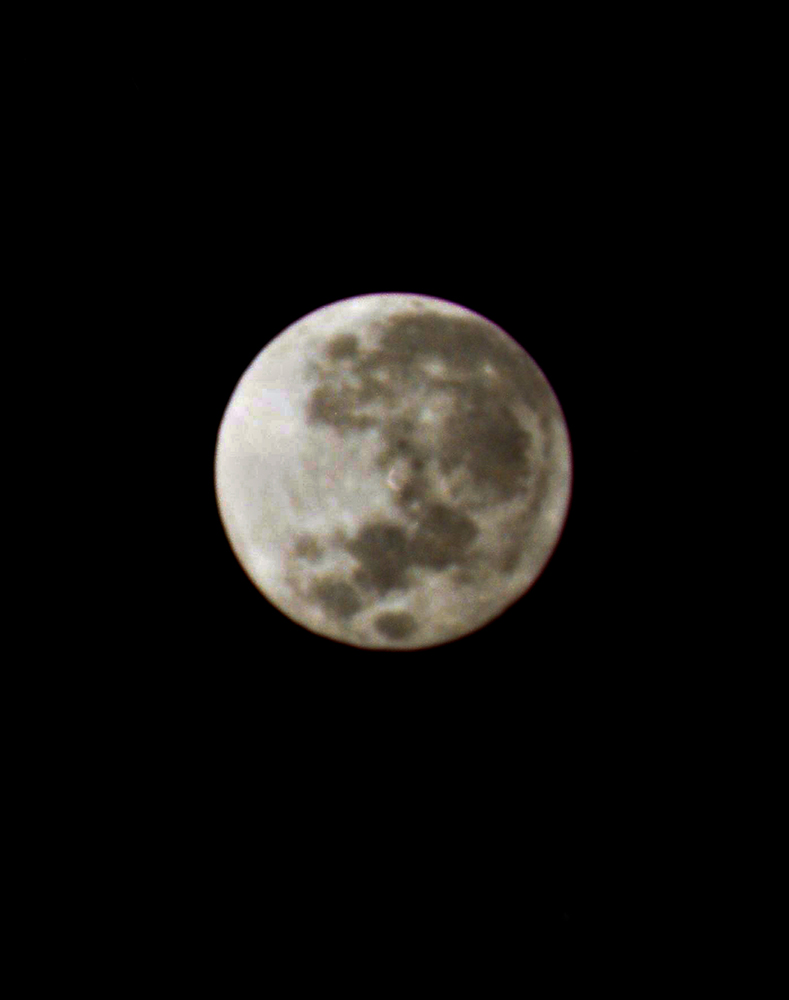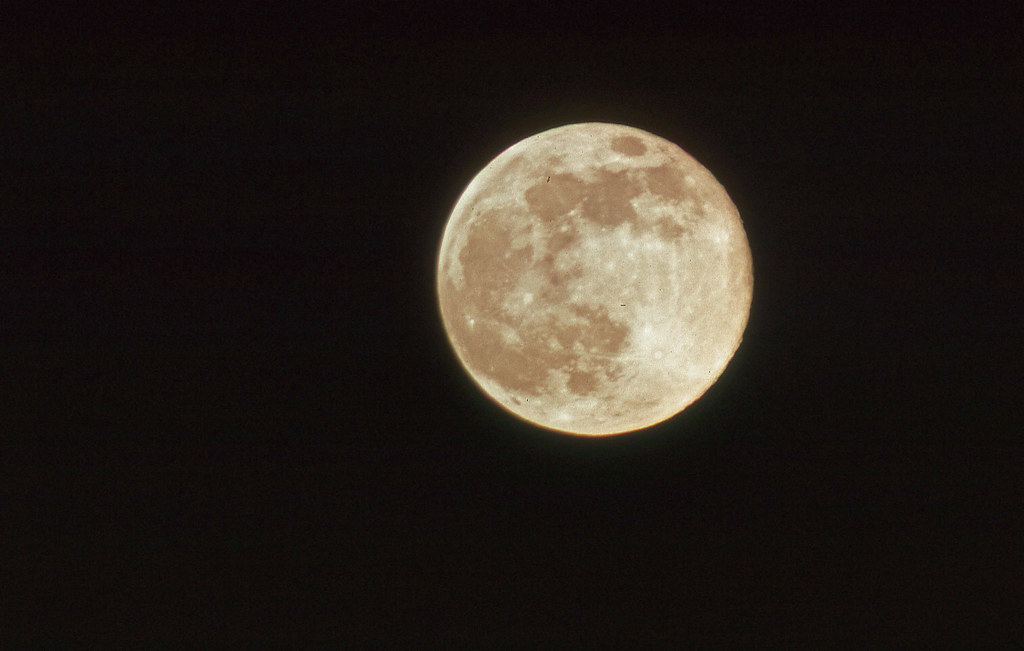and please use their services
You are using an out of date browser. It may not display this or other websites correctly.
You should upgrade or use an alternative browser.
You should upgrade or use an alternative browser.
Moonlight exposure
- Thread starter steveo_mcg
- Start date
StephenM
I know a Blithering Idiot
- Messages
- 4,955
- Name
- Stephen
- Edit My Images
- Yes
If you do actually want to calculate out the whole thing, if a lens is opened to f/0.5, the image will be the same brightness as the object (optical purists will object that this isn't strictly true due to aberrations, but we'll ignore that - the figure is close enough). Armed with that, you can calculate the light loss along the way to the final image.
excalibur2
My F4's Broken...
- Messages
- 11,768
- Name
- Brian
- Edit My Images
- Yes
Well I'm lucky in that I can see the moon from the bedroom window. So last night set the camera up, then went to bed and lucky I woke up at 1:00am when the moon was quite high and took a couple of shots and went back to bed again. Until I get the film dev will not know if I've got the exposure right as the T90 says f8 @ 1/15 with 2Xs converter and 200 iso.... What is annoying is the converter will not let me set the lens to "A" (auto) to let the camera work the exposure out, when set to shutter or aperture priority.
Asha
Blithering Idiot
- Messages
- 11,274
- Name
- Asha
- Edit My Images
- Yes
the T90 says f8 @ 1/15 with 2Xs converter and 200 iso.... .
Allowing for the converter, that sounds to me like the exposure will be in the ballpark [emoji106][emoji6]
excalibur2
My F4's Broken...
- Messages
- 11,768
- Name
- Brian
- Edit My Images
- Yes
Allowing for the converter, that sounds to me like the exposure will be in the ballpark [emoji106][emoji6]
Hope so, while you can go through a roll of film by using a range of shutter speeds to get a result...using a spotmeter should reduce the errors for correct exposure, then the latitude of film should reduce any further errors and get something decent....erm in theory
Pound Coin
Horatio Nelson
- Messages
- 4,294
- Edit My Images
- Yes
Ah, but there’s a difference, the weirdness of bright stars in a daylight sky.Also, you don't really want to give enough exposure to make the scene look like daylight (you might as well do it during the day) so give enough exposure to make it look like night.
Steve.
simon ess
Just call me Roxanne.
- Messages
- 9,601
- Edit My Images
- No
excalibur2
My F4's Broken...
- Messages
- 11,768
- Name
- Brian
- Edit My Images
- Yes
Well the gear I have and where I live I can't see me getting anything better 
What is probably letting me down is the 2Xs converter, not using a fast shutter speed and I don't live on top of a mountain so I'm giving up

What is probably letting me down is the 2Xs converter, not using a fast shutter speed and I don't live on top of a mountain so I'm giving up

- Messages
- 3,169
- Name
- North York Moors
- Edit My Images
- Yes
The moon itself generally looks better not full, you can actually see sunlight striking higher areas.
View attachment 254639
View attachment 254639
excalibur2
My F4's Broken...
- Messages
- 11,768
- Name
- Brian
- Edit My Images
- Yes
The moon itself generally looks better not full, you can actually see sunlight striking higher areas.
View attachment 254639
Well it would probably be easier, but if you went on all the digi forums and said "you can't get a decent detailed shot of a full moon using available camera equipment"....then someone is going to say "there you go with a shot"
For me if I had a decent 600mm lens (instead of 300mm with 2Xs converter) the shutter speed would be 1/60 for 200 iso @ f8,, but using 400iso film (which I didn't have) the shutter speed would be 1/125.....but then using a very good flat bed scanner this is the best I can get with a crop.
Somewhere away from the London area and the shot should be better, so that's that for me ATM.
- Messages
- 3,169
- Name
- North York Moors
- Edit My Images
- Yes
I'm not sure urban light pollution makes much difference taking a shot of the moon, it is actually very bright you almost work at daylight settings.
A moonlit landscape is a different matter!
A built up and lit landscape with moon hanging over it could be a very nice shot.
A moonlit landscape is a different matter!
A built up and lit landscape with moon hanging over it could be a very nice shot.
excalibur2
My F4's Broken...
- Messages
- 11,768
- Name
- Brian
- Edit My Images
- Yes
Well all I was trying to achieve was to see some detail on the moon and all I'm getting is smudges of darkness and light. Maybe I was expecting too much and you have to fit a camera onto a telescope to see a bit of detail...anyway all fun and experience.
- Messages
- 9,200
- Edit My Images
- No
Wait for a day with a clear sky when the moon's visible and you should be able to get a usable shot with anything that has a long enough lens. This was taken with a Sony HX90...Well all I was trying to achieve was to see some detail on the moon and all I'm getting is smudges of darkness and light.

It's possible to get night shots with a bit of messing about. This was taken with a Panasonic TZ70. The camera was set to shutter priority at 1/60th and the meter chose f6.4 at 400 ISO...

Neither of these shots reach the standards an astronomer would require.
excalibur2
My F4's Broken...
- Messages
- 11,768
- Name
- Brian
- Edit My Images
- Yes
Neither of these shots reach the standards an astronomer would require.
Well they are better than mine....interesting to take a shot of the moon in daylight and I wouldn't have thought of it.
Mr Badger
Didymus
- Messages
- 7,457
- Edit My Images
- No
Just when you thought you might have had the exposure thing sorted... http://www.msn.com/en-gb/news/uknew...ull-moon/ar-AAHcBRf?li=AAnZ9Ug&ocid=DELLDHP17
Roberts, a large brandy and a darkened room for Mr Brian please.
Roberts, a large brandy and a darkened room for Mr Brian please.
- Messages
- 3,169
- Name
- North York Moors
- Edit My Images
- Yes
There's the problem then, it's too far away just now 
Atmospheric conditions and haze are hard to judge at night, worth trying again especially now things are cooling down for winter.
I seem to remember getting decent results with an old Olympus compact which had 10x zoom.
Atmospheric conditions and haze are hard to judge at night, worth trying again especially now things are cooling down for winter.
I seem to remember getting decent results with an old Olympus compact which had 10x zoom.
excalibur2
My F4's Broken...
- Messages
- 11,768
- Name
- Brian
- Edit My Images
- Yes
Just when you thought you might have had the exposure thing sorted
Well even using the equivalent 600mm (2Xs 300mm) lens the moon is still small, on the neg, to see if I've got the exposure right

For newbies trying film who are reading this:- by looking at the neg you can see if you have got the exposure about right i.e. if the subject looks too dense then it's well over exposed and if it looks too thin then it's well under exposed.
excalibur2
My F4's Broken...
- Messages
- 11,768
- Name
- Brian
- Edit My Images
- Yes
Mr Badger
Didymus
- Messages
- 7,457
- Edit My Images
- No
What will that give you the equivalent of in mm (assuming it works and you can achieve focus)? However, I suspect that with 3 2x converters the resulting f number will be too high to give you a fast enough shutter speed to avoid motion blur (the moon moving in relation to the earth even if the camera can be kept steady)? Also, I wouldn't want to hang that lot off any camera mount, I'd certainly want the camera body hanging off a tripod mounted lens with that weight and leverage!
In respect of frame filling, as posted previously, I used a 400mm f6.3 with a single 3x converter (giving a 1200mm equivalent) to take this from my bedroom window many years ago when I was 16 - I hope your tripod is more sturdy than the one I used though!

In respect of frame filling, as posted previously, I used a 400mm f6.3 with a single 3x converter (giving a 1200mm equivalent) to take this from my bedroom window many years ago when I was 16 - I hope your tripod is more sturdy than the one I used though!

excalibur2
My F4's Broken...
- Messages
- 11,768
- Name
- Brian
- Edit My Images
- Yes
A digi camera mount breakerthree 2Xs converters with 300mm lens...h'mm image is a bit dark but well see what sort of shots it takes of the moon and elsewhere.
View attachment 255233
Quite amusing with three 2xs converters and a 300mm lens, the smaller harvest moon wont fit in the 35mm neg frame i.e. it's too large now. So guys if you see a 1800mm prime lens
excalibur2
My F4's Broken...
- Messages
- 11,768
- Name
- Brian
- Edit My Images
- Yes
P.S. Surely with 3 two times converters, the combined focal length is 2x2x2x300 = 2400mm not 1800mm?
H'mm I think you're right
Last edited:



